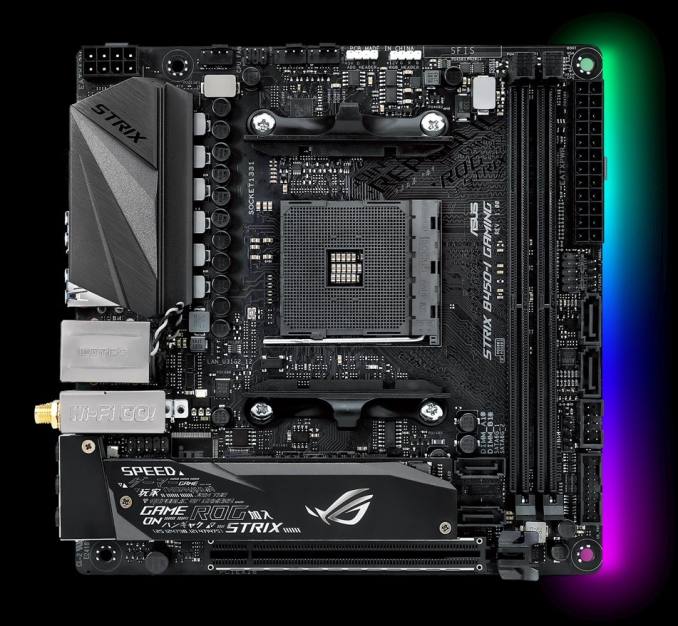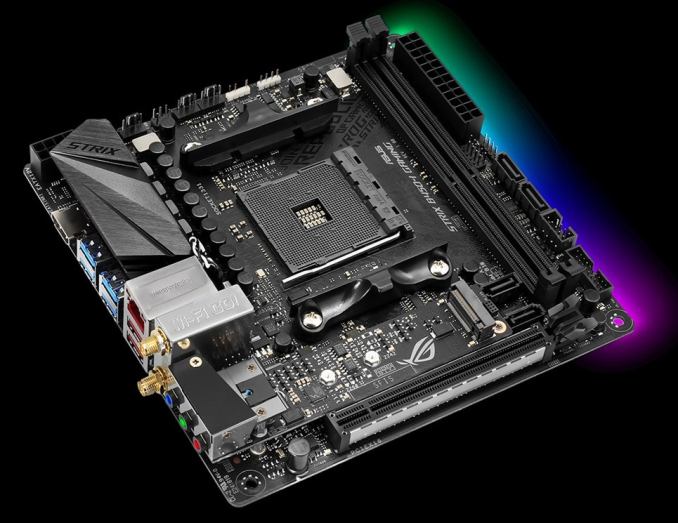Analyzing B450 for AMD Ryzen: A Quick Look at 25+ Motherboards
by Gavin Bonshor on July 31, 2018 8:00 AM ESTASUS ROG Strix B450-I Gaming
While the B450-I is the smaller sibling of the Strix B450-F, it packs a mighty punch in feature sets with a host of good quality components usually found on mITX form factor boards over the years from ASUS. The Strix B450-I includes a ROG SupremeFX S1220A audio codec with dual operational amplifiers, an Intel I211-AT Gigabit LAN controller and an Intel 802.11ac Wi-Fi adapter with MIMO capabilities built-in.
Looking closer at the Strix B450-I, the general theme follows that of the Strix B450-F board. The Strix B450-I follows a more subtle and clandestine style primarily due to its size, with a metallic grey heatsink which sits above the rear panel and MOSFETs. The RGB lighting built-in spans across the right-hand side of the board offers a unique and customizable under glow thanks to the ASUS Aura Sync technology which means it can be synchronized up with compatible peripherals and components such as graphics cards. On top of this are a single addressable RGB header and a regular RGB header.
Due to the size limitations on smaller form factor motherboards such as this one, there is only a single full-length PCIe 3.0 x16 slot which is covered in ASUS’s SafeSlot metallic armor coating to protect against slot damage from the heavier load bearing graphics cards.
Focusing on memory support, the smaller form factor has its benefits in this department as the ROG Strix B450-I supports up to DDR4-3600 with a maximum capacity of up to 32 GB of system memory split across two memory slots. Smaller form factor boards from ASUS generally tend to perform well in the memory stakes due to the closer tracks between the CPU socket and the RAM slots themselves, usually giving the memory lower latencies; although the benefits are marginal at best in real-world scenarios, they make quite a difference in situations such as benchmarking and sub-zero overclocking.
Touching more on the power capabilities, the Strix B450-I seems to feature an 8 phase Digi+ power delivery in a 6+2 configuration, with an 8-pin ATX 12 V power input to power the processor. In addition to this is a standard 24-pin ATX power connector featured on the right-hand side of the board.
The ASUS ROG Strix B450-I has a combined total of three 4-pin connectors spread across a dedicated header for a CPU fan, a single chassis fan connector and a specific connector for an AIO CPU cooler pump, or water cooling pump. Like most B450 motherboards, this particular model has a simple clear CMOS jumper instead of a button and has the capability to increase the number of USB ports through internal headers by a further two USB 3.1 5 Gbps and two USB 2.0 ports.
Making up the storage options on the Strix B450-I are four SATA 6 Gbps ports with all four of them being angled straight out of the board; we find two each on either side of the memory slots. The SATA 6 Gbps ports offer support for RAID 0, 1 and 10 arrays. In addition to the available SATA ports is a duo of M.2 slots with both slots accommodating drives up to M.2 2280 (22 x 80 mm), and both supporting the PCIe 3.0 x4 interface. One of the slots is located just above the full-length PCIe 3.0 x16 slot and features an integrated M.2 heatsink which has the futuristic text. The second slot is located on the rear of the PCB and features no cooling options other than available passive cooling from the system its installed into.
The audio is the same ROG SupremeFX S1220A audio codec found on the B450-F but is also supplemented by a pairing of operational amplifiers to further enhance the sound. Due to the size limitations, the SupremeFX S1220A codec only allows a total of three 3.5mm audio jacks on the rear panel, but they do contain an element of LED illuminated goodness; if that’s considered a selling point for an ITX board. In addition to the audio capabilities, the rear panel also has a total of four USB 3.1 5 Gbps Type-A ports and a pairing of USB 3.1 10 Gbps Type-A ports which are distinguished by their red color.
Finishing off the connections on the ROG Strix B450-I is an Intel I211-AT controlled Gigabit LAN port, two slots to attach the two included antennas to capitalize on the built-in 802.11ac MIMO 2T2R capable Wi-Fi module with Bluetooth 4.2 support, and last but most certainly not least, a single HDMI 2.0b capable video output for use with the Ryzen APUs.
It’s clear that the ROG Strix B450-I is a formidable offering featuring the same 8-phase Digi+ power delivery with two more than most ASUS B450 boards at launch, as well as a svelte integrated M.2 heatsink offering some function to users looking to utilize an NVMe capable drive in a small form factored PC, as well as some points in the style stakes too. The B450-I would be more suited to a powerful gamer with a beefy pixel rendering goliath such as an NVIDIA GTX 1080 Ti paired off with a Ryzen 2700X processor and DDR4-3600 memory for a pocket rocket gaming system. The expected retail price is currently unknown as of yet.





_thumb.jpg)
_thumb.jpg)
_thumb.jpg)
_thumb.jpg)
_thumb.jpg)
_thumb.jpg)








62 Comments
View All Comments
T1beriu - Tuesday, July 31, 2018 - link
Gavin, you made a table that shows B350 and A320 don't support PB2 and XFR2. This is incorrect. Raven Ridge (2400G, 2200G, 2X00U) work without a problem on these boards. Yes, Raven Ridge has PB2 and XFR2 from day one. AMD advertised it when they launched RR last year.https://www.amd.com/en/technologies/sense-mi
Ian Cutress - Tuesday, July 31, 2018 - link
It's not natively enabled from launch - it requires a BIOS update which not all vendors on all boards have provided. The CPUs work sure, but not all features of the CPUs will work in all products.T1beriu - Tuesday, July 31, 2018 - link
PB2 and XFR work on A320 as well.MrbigN - Wednesday, January 23, 2019 - link
If you buy the boards directly from there amazon store or on there website they should be Stock updated.As of, Jan,23 2019
bull2760 - Tuesday, July 31, 2018 - link
Please fix your charts. PCIe should be 3.0 not 2.0Ian Cutress - Tuesday, July 31, 2018 - link
The Chipset supports PCIe 2.0 lanes. PCIe 3.0 lanes come from the CPU.chrcoluk - Monday, August 30, 2021 - link
yeah but the 2nd x16 slot is also from the cpu and thus 3.0, you can even choose to make it a 8x slot in the bios by downgrading the first slot to 8x.The review incorrectly states the second full length slot is only 2.0.
T1beriu - Tuesday, July 31, 2018 - link
StoreMI can work on 300-series motherboards but comes with an additional fee (I don't think it's BIOS dependent).https://www.amd.com/en/technologies/store-mi
Ian Cutress - Tuesday, July 31, 2018 - link
The systems support 10 GbE, if you buy the cards. Yes it's picking hairs, but we're speaking native support.jtd871 - Tuesday, July 31, 2018 - link
What does 10GbE have to do with StoreMI?!